Related Research Articles
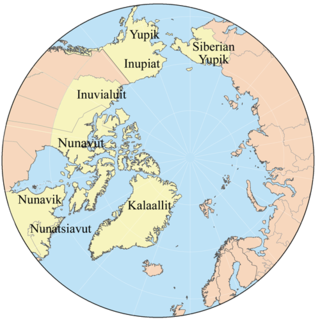
Eskimo is an exonym used to refer to two closely related Indigenous peoples: the Inuit and the Yupik of eastern Siberia and Alaska. A related third group, the Aleut, which inhabit the Aleutian Islands, are generally excluded from the definition of Eskimo. The three groups share a relatively recent common ancestor, and speak related languages belonging to the Eskaleut language family.

Greenland is an island country in North America that is part of the Kingdom of Denmark. It is located between the Arctic and Atlantic oceans, east of the Canadian Arctic Archipelago. Greenland is the world's largest island. It is one of three constituent countries that form the Kingdom of Denmark, along with Denmark and the Faroe Islands; the citizens of these countries are all citizens of Denmark and the European Union. Greenland's capital is Nuuk.

Knud Johan Victor Rasmussen was a Greenlandic–Danish polar explorer and anthropologist. He has been called the "father of Eskimology" and was the first European to cross the Northwest Passage via dog sled. He remains well known in Greenland, Denmark and among Canadian Inuit.

Robert Edwin Peary Sr. was an American explorer and officer in the United States Navy who made several expeditions to the Arctic in the late 19th and early 20th centuries. He is best known for, in April 1909, leading an expedition that claimed to be the first to have reached the geographic North Pole.
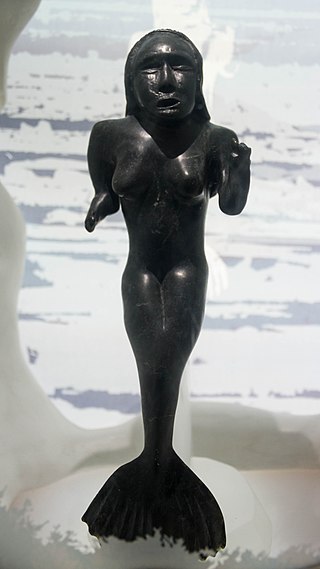
Inuit religion is the shared spiritual beliefs and practices of the Inuit, an indigenous people from Alaska, northern Canada, parts of Siberia and Greenland. Their religion shares many similarities with some Alaska Native religions. Traditional Inuit religious practices include animism and shamanism, in which spiritual healers mediate with spirits. Today many Inuit follow Christianity, but traditional Inuit spirituality continues as part of a living, oral tradition and part of contemporary Inuit society. Inuit who balance indigenous and Christian theology practice religious syncretism.

The music of Greenland is a mixture of two primary strands, Inuit and Danish, mixed with influences from the United States and United Kingdom.
The Paleo-Eskimo were the peoples who inhabited the Arctic region from Chukotka in present-day Russia across North America to Greenland prior to the arrival of the modern Inuit (Eskimo) and related cultures. The first known Paleo-Eskimo cultures developed by 2500 BCE, but were gradually displaced in most of the region, with the last one, the Dorset culture, disappearing around 1500 CE.

Diamond Jenness, was one of Canada's greatest early scientists and a pioneer of Canadian anthropology.
Kenn Harper is a Canadian writer, historian and former businessman. He is the author of Give Me My Father's Body, an account of Greenland Inuk Minik Wallace, had a regular column on Arctic history in Nunatsiaq News and is a former landlord.

Blonde Eskimos or Blond Eskimos is a term first applied in accounts of sightings of, and encounters with, light-haired Inuit peoples of Northern Canada from the early 20th century, particularly around the Coronation Gulf between mainland Canada and Victoria Island. Sightings of light-haired natives of the Arctic have been mentioned in written accounts as far back as the 17th century.

Qilakitsoq is an abandoned settlement and an important archaeological site in Greenland. It became known as the discovery location of eight mummified corpses from the Thule period. The Inuit mummies of Qilakitsoq offer important insights into the lives of Inuit about 500 years ago.

The Inughuit, or the Smith Sound Inuit, historically Arctic Highlanders, are Greenlandic Inuit. Formerly known as "Polar Eskimos", they are the northernmost group of Inuit and the northernmost people in North America, living in Greenland. Inughuit make up about 1% of the population of Greenland.
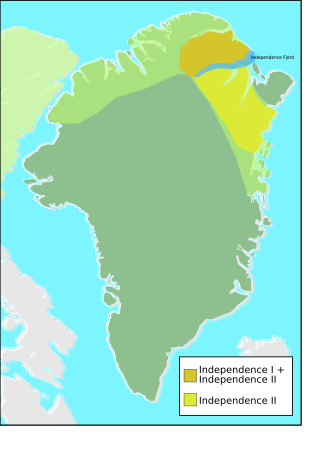
Independence I was a culture of Paleo-Eskimos who lived in northern Greenland and the Canadian Arctic between 2400 and 1900 BC. There has been much debate among scholars on when Independence I culture disappeared, and, therefore, there is a margin of uncertainty with the dates.
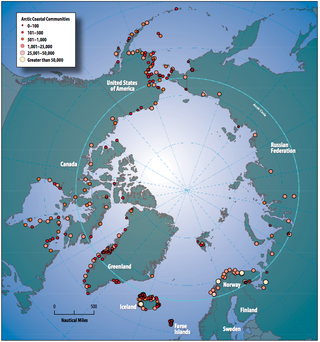
Circumpolar peoples and Arctic peoples are umbrella terms for the various indigenous peoples of the Arctic.

Inuit are a group of culturally similar indigenous peoples inhabiting the Arctic and subarctic regions of Greenland, Labrador, Quebec, Nunavut, the Northwest Territories, and Alaska. Inuit languages are part of the Eskimo–Aleut languages, also known as Inuit-Yupik-Unangan, and also as Eskaleut. Inuit Sign Language is a critically endangered language isolate used in Nunavut.
The Ilulissat Declaration was brought into force on May 28, 2008 by the five coastal states of the Arctic Ocean, following the Arctic Ocean Conference in Ilulissat, Greenland to discuss the Arctic Ocean, climate change, the protection of the marine environment, maritime safety, and division of emergency responsibilities if new shipping routes are opened.
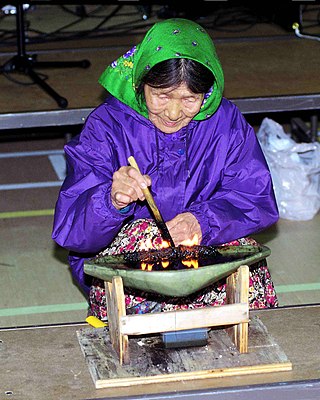
The Inuit are an indigenous people of the Arctic and subarctic regions of North America. The ancestors of the present-day Inuit are culturally related to Iñupiat, and Yupik, and the Aleut who live in the Aleutian Islands of Siberia and Alaska. The term culture of the Inuit, therefore, refers primarily to these areas; however, parallels to other Eskimo groups can also be drawn.
The Baháʼí Faith in Angola begins after ʻAbdu'l-Bahá wrote letters encouraging taking the religion to Africa in 1916. The first Baháʼí pioneered to Angola about 1952. By 1963 there was a Baháʼí Local Spiritual Assembly in Luanda and smaller groups of Baháʼís in other cities. In 1992 the Baháʼís of Angola elected their first National Spiritual Assembly. The Association of Religion Data Archives estimated some 2,000 Baháʼís in 2005.
The majority of the Greenlandic population is Christian and associates with the Church of Denmark via the Church of Greenland, which is Protestant in classification and Lutheran in orientation. The Church of Denmark is the established church through the Constitution of Denmark; this applies to all of the Kingdom of Denmark, except for the Faroe Islands, as the Church of the Faroe Islands became independent in 2007. But traditional Inuit spiritual beliefs remain strong in many of Greenland's remote communities.
References
- 1 2 "Referintinnen". Institut für Ethnomedizin. Retrieved 16 February 2023.
- 1 2 3 4 "Jens Lyberth". Det Danske Filminstitut. Retrieved 16 February 2023.
- 1 2 3 Birgitte Sonne (2017). Worldviews of the Greenlanders: An Inuit Arctic Perspective. United States: University of Alaska Press.
- ↑ Michael E. Tigar (2007). Thinking about Terrorism: The Threat to Civil Liberties in Times of National Emergency. United States: American Bar Association.
- ↑ Tucker, Linda (2013). Saving the White Lions One Woman's Battle for Africa's Most Sacred Animal. United States: North Atlantic Books. pp. 71–72. ISBN 9781583946206.
- ↑ "On-line Video Descriptions" (PDF). Inuit Broadcasting Corporation. November 4, 2016. p. 250. Retrieved 15 February 2023.
At Baha'i House in Iqaluit, Angaangaq Lyberth, a member of the Baha'i community and originally from Greenland, chants in Inuktitut and Arabic. He gives introductory information on some of the principles of the Baha'i Faith (a world religion) and explains some of the beliefs.
- 1 2 McIntosh, Ian S. "The UN Millennium World Peace Summit Of Religious And Spiritual Leaders". Cultural Survival. Retrieved 15 February 2023.
- ↑ Jackson, Drew; Dittmer, Kyle (August 2007). "Chapter channel". Bulletin of the American Meteorological Society. 88 (8): 1174–1176.
- ↑ "Angaangaq Lyberth, Monday, 1 September 2008 - Monday, 8 September 2008". Arctic Research Consortium of the United States (ARCUS). Retrieved 15 February 2023.
- ↑ "Sirmiq Aattuq (Melting The Ice In The Heart Of Man) Ltd". OpenCorporates. Retrieved 16 February 2023.